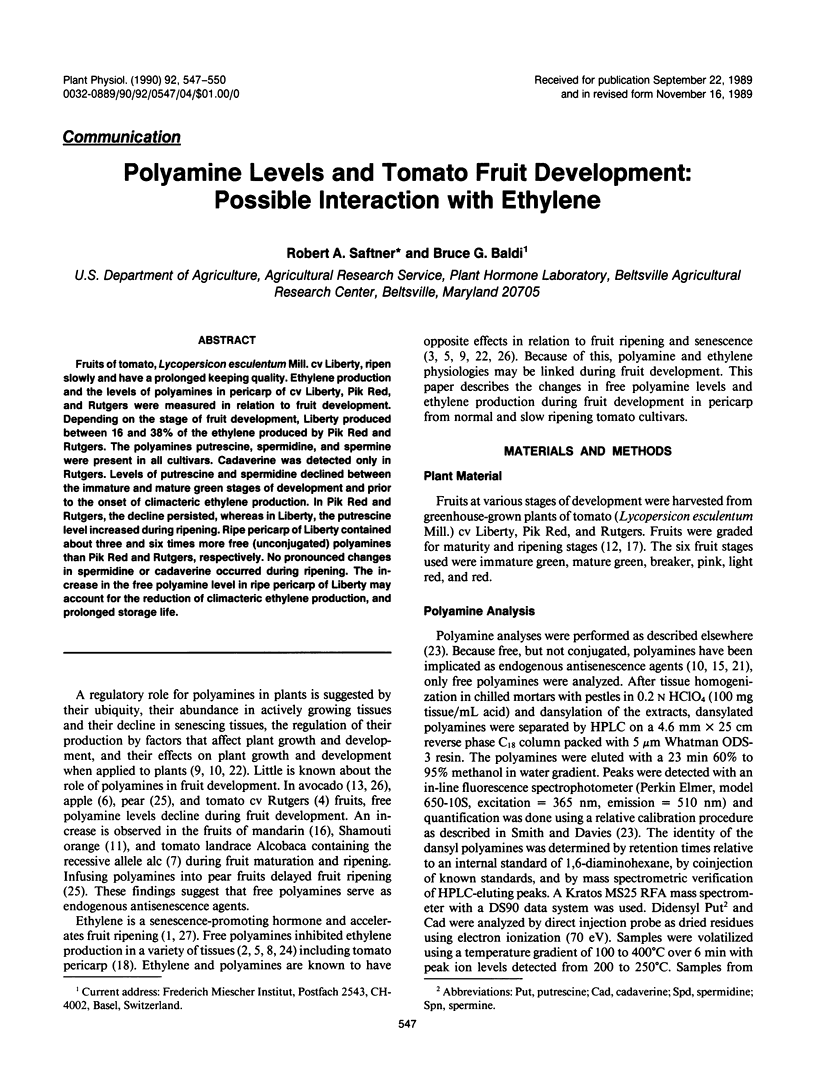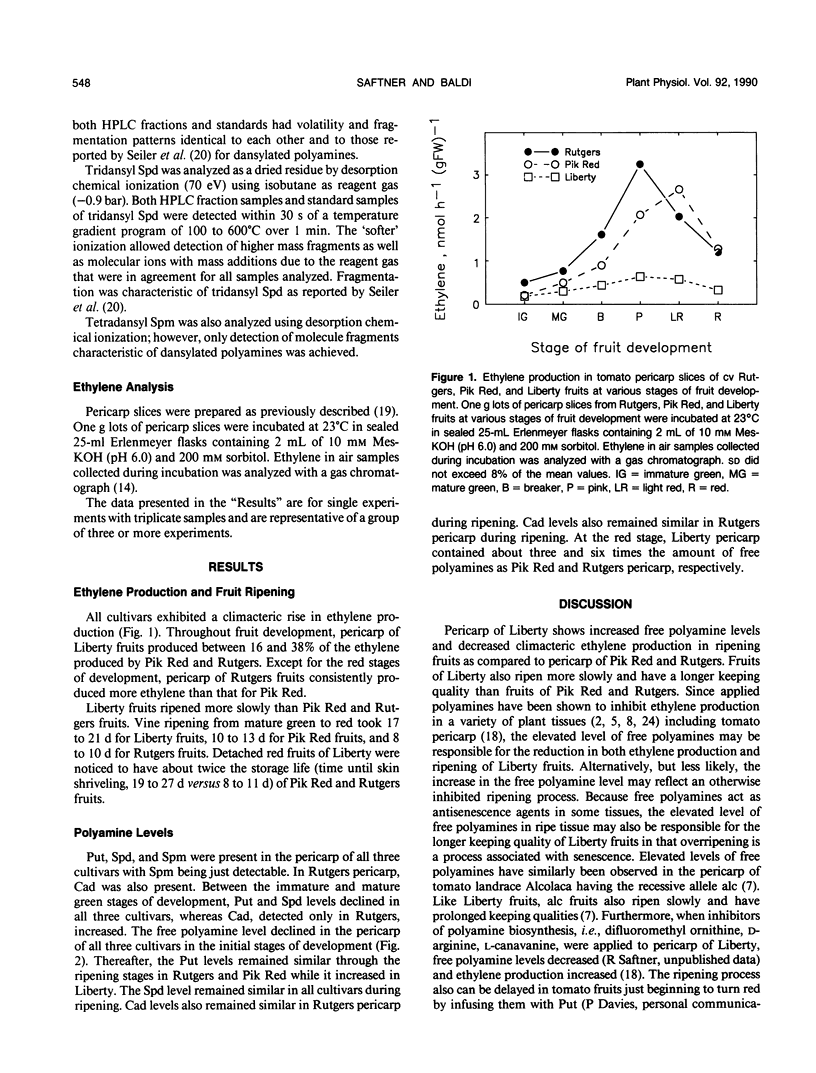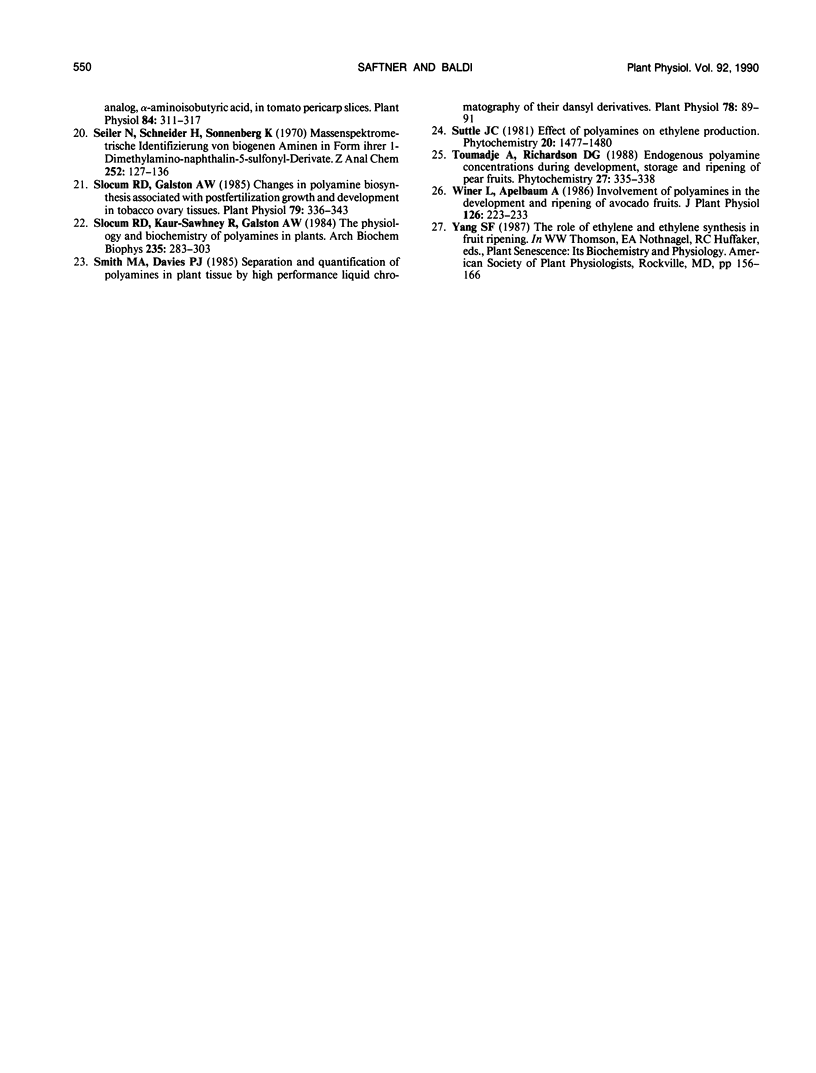Abstract
Fruits of tomato, Lycopersicon esculentum Mill. cv Liberty, ripen slowly and have a prolonged keeping quality. Ethylene production and the levels of polyamines in pericarp of cv Liberty, Pik Red, and Rutgers were measured in relation to fruit development. Depending on the stage of fruit development, Liberty produced between 16 and 38% of the ethylene produced by Pik Red and Rutgers. The polyamines putrescine, spermidine, and spermine were present in all cultivars. Cadaverine was detected only in Rutgers. Levels of putrescine and spermidine declined between the immature and mature green stages of development and prior to the onset of climacteric ethylene production. In Pik Red and Rutgers, the decline persisted, whereas in Liberty, the putrescine level increased during ripening. Ripe pericarp of Liberty contained about three and six times more free (unconjugated) polyamines than Pik Red and Rutgers, respectively. No pronounced changes in spermidine or cadaverine occurred during ripening. The increase in the free polyamine level in ripe pericarp of Liberty may account for the reduction of climacteric ethylene production, and prolonged storage life.
Full text
PDF



Selected References
These references are in PubMed. This may not be the complete list of references from this article.
- Apelbaum A., Burgoon A. C., Anderson J. D., Lieberman M. Polyamines inhibit biosynthesis of ethylene in higher plant tissue and fruit protoplasts. Plant Physiol. 1981 Aug;68(2):453–456. doi: 10.1104/pp.68.2.453. [DOI] [PMC free article] [PubMed] [Google Scholar]
- Apelbaum A., Goldlust A., Icekson I. Control by ethylene of arginine decarboxylase activity in pea seedlings and its implication for hormonal regulation of plant growth. Plant Physiol. 1985 Nov;79(3):635–640. doi: 10.1104/pp.79.3.635. [DOI] [PMC free article] [PubMed] [Google Scholar]
- Dibble A. R., Davies P. J., Mutschler M. A. Polyamine content of long-keeping alcobaca tomato fruit. Plant Physiol. 1988 Feb;86(2):338–340. doi: 10.1104/pp.86.2.338. [DOI] [PMC free article] [PubMed] [Google Scholar]
- Even-Chen Z., Mattoo A. K., Goren R. Inhibition of ethylene biosynthesis by aminoethoxyvinylglycine and by polyamines shunts label from 3,4-[C]methionine into spermidine in aged orange peel discs. Plant Physiol. 1982 Feb;69(2):385–388. doi: 10.1104/pp.69.2.385. [DOI] [PMC free article] [PubMed] [Google Scholar]
- Kushad M. M., Yelenosky G., Knight R. Interrelationship of Polyamine and Ethylene Biosynthesis during Avocado Fruit Development and Ripening. Plant Physiol. 1988 Jun;87(2):463–467. doi: 10.1104/pp.87.2.463. [DOI] [PMC free article] [PubMed] [Google Scholar]
- Lieberman M., Kunishi A. Stimulation of ethylene production in apple tissue slices by methionine. Plant Physiol. 1966 Mar;41(3):376–382. doi: 10.1104/pp.41.3.376. [DOI] [PMC free article] [PubMed] [Google Scholar]
- Saftner R. A., Baker J. E. Transport and Compartmentation of 1-Aminocyclopropane-1-Carboxylic Acid and Its Structural Analog, alpha-Aminoisobutyric Acid, in Tomato Pericarp Slices. Plant Physiol. 1987 Jun;84(2):311–317. doi: 10.1104/pp.84.2.311. [DOI] [PMC free article] [PubMed] [Google Scholar]
- Slocum R. D., Galston A. W. Changes in polyamine biosynthesis associated with postfertilization growth and development in tobacco ovary tissues. Plant Physiol. 1985;79:336–343. doi: 10.1104/pp.79.2.336. [DOI] [PMC free article] [PubMed] [Google Scholar]
- Slocum R. D., Kaur-Sawhney R., Galston A. W. The physiology and biochemistry of polyamines in plants. Arch Biochem Biophys. 1984 Dec;235(2):283–303. doi: 10.1016/0003-9861(84)90201-7. [DOI] [PubMed] [Google Scholar]


